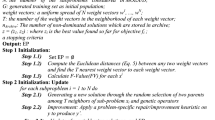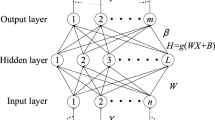Abstract
Ensemble learning is an important element in machine learning. However, two essential tasks, including training base classifiers and finding a suitable ensemble balance for the diversity and accuracy of these base classifiers, are need to be achieved. In this paper, a novel ensemble method, which utilizes a multimodal multiobjective differential evolution (MMODE) algorithm to select feature subsets and optimize base classifiers parameters, is proposed. Moreover, three methods including minimum error ensemble, all Pareto sets ensemble, and error reduction ensemble are employed to construct ensemble classifiers for executing classification tasks. Experimental results on several benchmark classification databases evidence that the proposed algorithm is valid.
Access this chapter
Tax calculation will be finalised at checkout
Purchases are for personal use only
Similar content being viewed by others
References
Song, Y., et al.: Gaussian derivative models and ensemble extreme learning machine for texture image classification. Neurocomputing 277, 53–64 (2018)
Piri, S., Delen, D., Liu, T., Zolbanin, H.M.: A data analytics approach to building a clinical decision support system for diabetic retinopathy: developing and deploying a model ensemble. Decis. Support Syst. 101, 12–27 (2017)
Zhao, Z., Jiao, L., Liu, F., Zhao, J., Chen, P.: Semisupervised discriminant feature learning for SAR image category via sparse ensemble. IEEE Trans. Geosci. Remote Sens. 54(6), 3532–3547 (2016)
Breiman, L.: Bagging predictors. Mach. Learn 24(2), 123–140 (1996)
Freund, Y., Schapire, R.E.: A decision-theoretic generalization of on-line learning and an application to boosting. J. Comput. Syst. Sci. 55(1), 119–139 (1997)
Breiman, L.: Random forests. Mach. Learn. 45(1), 5–32 (2001)
Rodriguez, J.J., Kuncheva, L.I., Alonso, C.J.: Rotation forest: a new classifier ensemble method. IEEE Trans. Pattern Anal. Mach. Intell. 28(10), 1619–1630 (2006)
Fernández, A., Carmona, C.J., Jose del Jesus, M., Herrera, F.: A Pareto-based ensemble with feature and instance selection for learning from multi-class imbalanced datasets. Int. J. Neural Syst. 27(06), 1750028 (2017)
Albukhanajer, W.A., Jin, Y., Briffa, J.A.: Classifier ensembles for image identification using multi-objective Pareto features. Neurocomputing 238, 316–327 (2017)
Lyu, H., Wan, M., Han, J., Liu, R., Wang, C.: A filter feature selection method based on the maximal information coefficient and Gram-Schmidt orthogonalization for biomedical data mining. Comput. Biol. Med. 89, 264–274 (2017)
Guyon, I., Elisseeff, A.: An introduction to variable and feature selection. J. Mach. Learn. Res. 3, 1157–1182 (2003)
Kohavi, R., John, G.H.: Wrappers for feature subset selection. Artif. Intell. 97(1–2), 273–324 (1997)
Xue, X., Yao, M., Wu, Z.: A novel ensemble-based wrapper method for feature selection using extreme learning machine and genetic algorithm. Knowl. Inf. Syst. 57(2), 389–412 (2017). https://doi.org/10.1007/s10115-017-1131-4
Zhang, Y., Gong, D., Cheng, J.: Multi-objective particle swarm optimization approach for cost-based feature selection in classification. IEEE/ACM Trans. Comput. Biol. Bioinf. (TCBB) 14(1), 64–75 (2017)
Quinlan, J.R.: Improved use of continuous attributes in C4.5. J. Artif. Intell. Res. 4, 77–90 (1996)
Kamyab, S., Eftekhari, M.: Feature selection using multimodal optimization techniques. Neurocomputing 171, 586–597 (2016)
Pan, L., Li, L., He, C., Tan, K.C.: A subregion division-based evolutionary algorithm with effective mating selection for many-objective optimization. IEEE Trans. Cybern. (2019). https://doi.org/10.1109/TCYB.2019.2906679
He, C., Tian, Y., Jin, Y., Zhang, X., Pan, L.: A radial space division based evolutionary algorithm for many-objective optimization. Appl. Soft Comput. 61, 603–621 (2017)
Yue, C., Qu, B., Liang, J.: A multiobjective particle swarm optimizer using ring topology for solving multimodal multiobjective problems. IEEE Trans. Evol. Comput. 22(5), 805–817 (2017)
Deb, K., Tiwari, S.: Omni-optimizer: a procedure for single and multi-objective optimization. In: Coello Coello, C.A., Hernández Aguirre, A., Zitzler, E. (eds.) EMO 2005. LNCS, vol. 3410, pp. 47–61. Springer, Heidelberg (2005). https://doi.org/10.1007/978-3-540-31880-4_4
Liang, J., Guo, Q., Yue, C., Qu, B., Yu, K.: A self-organizing multi-objective particle swarm optimization algorithm for multimodal multi-objective problems. In: Tan, Y., Shi, Y., Tang, Q. (eds.) ICSI 2018. LNCS, vol. 10941, pp. 550–560. Springer, Cham (2018). https://doi.org/10.1007/978-3-319-93815-8_52
Dua, D., Graff, C.: UCI machine learning repository (2017). http://archive.ics.uci.edu/ml
Tanabe, R., Ishibuchi, H.: A review of evolutionary multimodal multiobjective optimization. IEEE Trans. Evol. Comput. 24(1), 193–200 (2020). ISSN 1941-0026
Li, X., Epitropakis, M.G., Deb, K., Engelbrecht, A.: Seeking multiple solutions: an updated survey on niching methods and their applications. IEEE Trans. Evol. Comput. 21(4), 518–538 (2017)
Liang, J., et al.: Multimodal multiobjective optimization with differential evolution. Swarm Evol. Comput. 44, 1028–1059 (2019)
Shir, O.M., Preuss, M., Naujoks, B., Emmerich, M.: Enhancing decision space diversity in evolutionary multiobjective algorithms. In: Ehrgott, M., Fonseca, C.M., Gandibleux, X., Hao, J.-K., Sevaux, M. (eds.) EMO 2009. LNCS, vol. 5467, pp. 95–109. Springer, Heidelberg (2009). https://doi.org/10.1007/978-3-642-01020-0_12
Sikdar, U.K., Ekbal, A., Saha, S.: MODE: multiobjective differential evolution for feature selection and classifier ensemble. Soft Comput. 19(12), 3529–3549 (2015). https://doi.org/10.1007/s00500-014-1565-5
Whitney, A.W.: A direct method of nonparametric measurement selection. IEEE Trans. Comput. 100(9), 1100–1103 (1971)
Marill, T., Green, D.: On the effectiveness of receptors in recognition systems. IEEE Trans. Inf. Theory 9(1), 11–17 (1963)
Yusta, S.C.: Different metaheuristic strategies to solve the feature selection problem. Pattern Recogn. Lett. 30(5), 525–534 (2009)
Pan, L., He, C., Tian, Y., Wang, H., Zhang, X., Jin, Y.: A classification-based surrogate-assisted evolutionary algorithm for expensive many-objective optimization. IEEE Trans. Evol. Comput. 23(1), 74–88 (2018)
Pan, L., He, C., Tian, Y., Su, Y., Zhang, X.: A region division based diversity maintaining approach for many-objective optimization. Integr. Comput. Aided Eng. 24(3), 279–296 (2017)
Wang, X., Yang, J., Teng, X., Xia, W., Jensen, R.: Feature selection based on rough sets and particle swarm optimization. Pattern Recogn. Lett. 28(4), 459–471 (2007)
Yu, K., Qu, B., Yue, C., Ge, S., Chen, X., Liang, J.: A performance-guided jaya algorithm for parameters identification of photovoltaic cell and module. Appl. Energy 237, 241–257 (2019)
Huang, C.L., Wang, C.J.: A GA-based feature selection and parameters optimizationfor support vector machines. Expert Syst. Appl. 31(2), 231–240 (2006)
Wan, Y., Wang, M., Ye, Z., Lai, X.: A feature selection method based on modified binary coded ant colony optimization algorithm. Appl. Soft Comput. 49, 248–258 (2016)
Huang, G.B., Zhu, Q.Y., Siew, C.K.: Extreme learning machine: theory and applications. Neurocomputing 70(1–3), 489–501 (2006)
Huang, G.B., Chen, L., Siew, C.K., et al.: Universal approximation using incremental constructive feedforward networks with random hidden nodes. IEEE Trans. Neural Networks 17(4), 879–892 (2006)
Feng, G., Huang, G.B., Lin, Q., Gay, R.: Error minimized extreme learning machine with growth of hidden nodes and incremental learning. IEEE Trans. Neural Networks 20(8), 1352–1357 (2009)
Xu, Z., Yao, M., Wu, Z., Dai, W.: Incremental regularized extreme learning machine and it’s enhancement. Neurocomputing 174, 134–142 (2016)
Cao, J., Lin, Z., Huang, G.B., Liu, N.: Voting based extreme learning machine. Inf. Sci. 185(1), 66–77 (2012)
Rosales-Perez, A., Garcia, S., Gonzalez, J.A., Coello, C.A.C., Herrera, F.: An evolutionary multi-objective model and instance selection for support vector machines with Pareto-based ensembles. IEEE Trans. Evol. Comput. 21(6), 863–877 (2017)
García-Nieto, J., Alba, E., Jourdan, L., Talbi, E.: Sensitivity and specificity based multiobjective approach for feature selection: application to cancer diagnosis. Inf. Process. Lett. 109(16), 887–896 (2009)
Chang, C.C., Lin, C.J.: LIBSVM: a library for support vector machines. ACM Trans. Intell. Syst. Technol. (TIST) 2(3), 27 (2011)
Acknowledgments
This work is supported by the National Natural Science Foundation of China (61976237, 61922072, 61876169, 61673404).
Author information
Authors and Affiliations
Corresponding author
Editor information
Editors and Affiliations
Rights and permissions
Copyright information
© 2020 Springer Nature Singapore Pte Ltd.
About this paper
Cite this paper
Wang, J., Wang, B., Liang, J., Yu, K., Yue, C., Ren, X. (2020). Ensemble Learning via Multimodal Multiobjective Differential Evolution and Feature Selection. In: Pan, L., Liang, J., Qu, B. (eds) Bio-inspired Computing: Theories and Applications. BIC-TA 2019. Communications in Computer and Information Science, vol 1159. Springer, Singapore. https://doi.org/10.1007/978-981-15-3425-6_34
Download citation
DOI: https://doi.org/10.1007/978-981-15-3425-6_34
Published:
Publisher Name: Springer, Singapore
Print ISBN: 978-981-15-3424-9
Online ISBN: 978-981-15-3425-6
eBook Packages: Computer ScienceComputer Science (R0)




